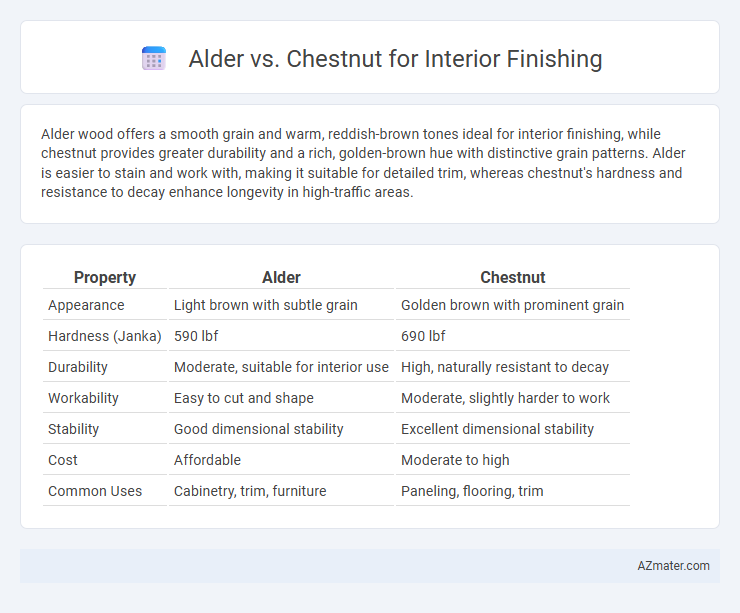Alder wood offers a smooth grain and warm, reddish-brown tones ideal for interior finishing, while chestnut provides greater durability and a rich, golden-brown hue with distinctive grain patterns. Alder is easier to stain and work with, making it suitable for detailed trim, whereas chestnut's hardness and resistance to decay enhance longevity in high-traffic areas.
Table of Comparison
| Property | Alder | Chestnut |
|---|---|---|
| Appearance | Light brown with subtle grain | Golden brown with prominent grain |
| Hardness (Janka) | 590 lbf | 690 lbf |
| Durability | Moderate, suitable for interior use | High, naturally resistant to decay |
| Workability | Easy to cut and shape | Moderate, slightly harder to work |
| Stability | Good dimensional stability | Excellent dimensional stability |
| Cost | Affordable | Moderate to high |
| Common Uses | Cabinetry, trim, furniture | Paneling, flooring, trim |
Introduction to Alder and Chestnut Wood
Alder wood, known for its fine, consistent grain and light brown hue with reddish undertones, offers a smooth surface ideal for staining and painting in interior finishing projects. Chestnut wood, characterized by its coarse texture and warm golden-brown color that darkens with age, provides strong durability and a rustic aesthetic favored in cabinetry and paneling. Both woods deliver distinct visual appeal and workability, making them popular choices depending on design preferences and functional requirements.
Appearance and Grain Patterns
Alder wood features a smooth, fine grain with a uniform texture and warm, reddish-brown tones, offering a subtle and consistent look ideal for contemporary interior finishing. Chestnut displays a coarser, more pronounced grain with distinctive growth rings and rich golden-brown hues that create a rustic and natural aesthetic. The choice between alder and chestnut ultimately depends on the desired visual impact, with alder providing a sleek, understated elegance and chestnut emphasizing character and warmth through its bold grain patterns.
Durability and Hardness Comparison
Alder wood, with a Janka hardness of approximately 590, offers moderate durability suitable for interior finishing, but it is softer and more prone to dents and scratches compared to chestnut. American chestnut, historically valued for its superior hardness around 540 to 700 on the Janka scale depending on the species, provides better resistance to wear and impact, making it a more durable choice for high-traffic interior applications. Chestnut's natural rot resistance and strength enhance its longevity in flooring and cabinetry, whereas alder's workability and finer grain are more suited for decorative, low-stress interior elements.
Workability and Ease of Use
Alder wood offers excellent workability due to its soft texture and fine grain, making it easy to cut, shape, and sand for interior finishing projects. Chestnut, while slightly harder and more durable, requires sharper tools and more effort for precise detailing but provides a rustic, rich finish. Both woods respond well to staining and finishing, though alder's smoother surface often results in more consistent and clean results for intricate designs.
Color Variations and Aging
Alder wood offers a warm, light brown color with subtle reddish hues that deepen into a rich amber tone over time, creating a smooth and uniform aging process ideal for interior finishing. Chestnut presents a more varied color palette, ranging from golden yellow to deep brown with prominent grain patterns that darken unevenly, adding character and rustic charm as it ages. Choosing between alder and chestnut hinges on desired interior aesthetics, with alder providing consistent warmth and chestnut delivering dynamic, textured color evolution.
Cost and Availability
Alder wood generally offers a more cost-effective option for interior finishing compared to chestnut, making it a popular choice for budget-conscious projects. Alder is widely available due to its fast growth and abundant supply in North America, ensuring consistent access and lower prices. Chestnut, while prized for its durability and unique grain, is rarer and often more expensive due to limited availability and slower growth rates.
Environmental Impact and Sustainability
Alder wood, known for its rapid growth and renewability, offers a more sustainable choice for interior finishing compared to chestnut, which grows slower and is less abundant. Chestnut wood, though durable and resistant to decay, often requires sourcing from older forests, raising concerns about deforestation and habitat loss. Selecting alder supports responsible forestry practices and reduces carbon footprint, making it preferable from an environmental impact perspective.
Maintenance and Longevity
Alder wood offers a softer texture that requires more frequent maintenance such as regular sealing and careful handling to prevent dents and scratches, making it less durable than Chestnut. Chestnut, known for its hardness and natural resistance to decay and insects, provides superior longevity with minimal upkeep, ideal for high-traffic interior finishes. Selecting Chestnut ensures enhanced durability and reduced maintenance costs over time, while Alder suits applications where aesthetic warmth is prioritized over extended lifespan.
Best Applications in Interior Design
Alder wood offers a smooth, fine grain with warm, reddish-brown tones, making it ideal for cabinetry, trim, and furniture in rustic or traditional interior designs. Chestnut features a distinctive coarse grain and rich, golden-brown color, best suited for flooring, paneling, and accent walls that require durability and a historic or natural aesthetic. Both woods excel in creating inviting, textured spaces but alder is preferred for detailed joinery and finishes, while chestnut is favored for structural elements and high-traffic areas.
Choosing the Right Wood for Your Project
Alder offers a smooth texture and consistent grain, making it ideal for interior finishing projects requiring a warm, uniform appearance. Chestnut provides greater durability and rich, pronounced grain patterns that enhance rustic or traditional designs. Selecting between alder and chestnut depends on the desired aesthetic, durability needs, and budget constraints for your interior woodwork.

Infographic: Alder vs Chestnut for Interior Finishing
 azmater.com
azmater.com